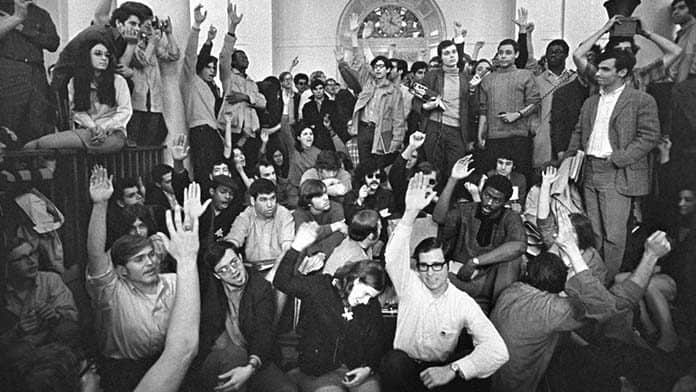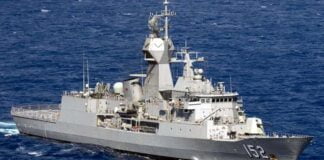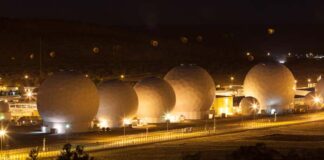The US student movement in the 1960s began by rejecting ideology and the ‘old left’, but was soon forced to grapple with the power of capitalism and the state, says Sophie Cotton
A new wave of climate activism has emerged largely outside the established left, from high school strikes to “extinction rebellion”. Many are making comparisons to the fight against the Vietnam War in the 1960s. This history contains important lessons about the danger of ignoring political ideology and the centrality of the working class.
Students played a central role in opposing the Vietnam War in the US. Students for a Democratic Society (SDS) grew from a small organisation of less than 1000 members in the early 1960s to one encompassing as many as 100,000 members and over 300 branches by 1969.
But June this year marked 50 years since the organisation collapsed. From an organising centre able to bring together thousands of activists, SDS was defunct within the year.
SDSers saw themselves as breaking out of a historical Cold War impasse on the Left.
Their first statement of principles, the Port Huron statement, dismissed the “liberal and socialist preachments of the past”, including the supposedly obsolete concerns of the socialist left such as the working class and revolution.
As SDS leader Tom Hayden wrote in 1966, the, “traditional Left expectation of irreconcilable and clashing class interests has been defied. It appears that the American elite has discovered a long-term way to stabilize or cushion the contradictions of our society”.
Another leader described activists as, “staunchly anti-intellectual… In one sense they have no politics… They are morally outraged about the war, cops, racism, poverty, their parents, the middle class and authority in general”.
The Port Huron statement declared the SDS in favour of “participatory democracy” and non-violence. But these pleasant ideals came into increasing conflict with their experiences of extreme state violence and the patent lack of democracy.
Anti-war activism grows
The campaign against the Vietnam War turned SDS into a national force. In the 1964 presidential election, they raised the slogan “Half the way with LBJ”—backing the Democratic Party’s Lyndon B. Johnson against Republican Barry Goldwater.
But four months after he rolled to victory, LBJ began the largest bombing campaign in the history of warfare. This escalation of the Vietnam War pushed students into an increasingly outraged anti-war movement.
Across the country over 100 colleges organised “teach-ins”. US government officials and anti-war activists debated the war on equal terms in front of tens of thousands of students—3000 attended the first teach-in at the University of Michigan. Anti-war ideas gained a mass audience.
Protest found a growing audience too. Observers were shocked when 20,000 attended the first national demonstration against the war in April 1965, called by SDS.
The year 1968 was a turning point. The Vietnamese Tet offensive in January demolished the idea that the US was winning the war. Civil rights leader Martin Luther King was murdered in April, provoking riots. Democratic Party presidential hopeful Robert Kennedy was assassinated in June.
And from Prague to Paris, student and worker uprisings were exploding worldwide.
State repression in Chicago
The protests at the Democratic National Convention (DNC) in Chicago in August transformed a generation of activists.
Dogged by an increasingly unpopular war, LBJ’s popularity had plummeted to 36 per cent, and he withdrew from the race. SDS called a demonstration outside the DNC, at which hopes were high that anti-war candidate Eugene McCarthy would win the Democratic nomination.
Students descended on the conference. Hundreds camped at Lincoln Park. At its height, the demonstration swelled to 10,000.
However, protesters were met with the full might of a Democratic Party machine determined to install Hubert Humphrey, the pro-war establishment candidate, by any means necessary. He had not even been a candidate in any of the primaries, which were won overwhelmingly by anti-war candidates.
Democratic Chicago Mayor Richard Daley mobilised 12,000 police, 5000 national guardsmen, and 7500 troops to drive protesters off the streets.
Demonstrators braved repression for two consecutive nights before staging a march through Chicago on the day of the convention vote. Images were beamed across the world of police carving up the stationary demonstration with tear gas and clubs and chasing down individuals. The violence was indiscriminate. Village Voice reported:
“Demonstrators, reporters, McCarthy workers, doctors, all began to stagger into the Hilton [hotel] lobby, blood streaming from face and head wounds… A few people began to direct the wounded to a makeshift hospital on the fifteenth floor, the McCarthy staff headquarters”.
This extended inside the conference, where delegates were leaving the floor to watch coverage of the protests outside. One reporter was punched in the jaw. A delegate was dragged from the room by cops after refusing to resume his seat. One senator decried the “Gestapo tactics”.
Humphrey was installed as the Democratic candidate—stunning those who had thought the party might end the war.
America’s rulers claimed to stand for freedom against the Communist dictatorships in Russia and Eastern Europe, which were busily crushing the Prague Spring uprising in Czechoslovakia. But at the heart of American capitalism students found similar repression.
Activists drew the parallels: “Chicago is fast becoming the Prague of the midwest”.
Political radicalisation
The events of 1968 crystalised and accelerated the process of political radicalization. Independent Socialists Weinberg and Gerson wrote, “What began as a movement in many ways resembling a super-idealistic children’s crusade to save the world, was becoming increasingly grim and increasingly serious”.
Activists had previously dismissed ideology. But state repression was making it clear that the establishment was determined to continue the war at any cost, and was entirely prepared to crush the anti-war movement to do so.
The idea that the US was a democratic country whose institutions could be persuaded to end the war through non-violent protests could neither satisfyingly explain the repression nor suggest a way forward.
By the 1969 conference, every major faction within SDS had adopted some version of Marxism. One 1968 SDS leader described the turn, “We’d done everything we could think of in our liberal, radical, anarchist, socialist framework… but still it wasn’t enough”.
This reflected a general radicalisation amongst huge numbers of students. In 1968, over 350,000 students “strongly agreed” that some kind of “mass revolutionary party” was needed in the US, and a poll in 1969 found that over one million students considered themselves revolutionaries and socialists of some kind.
But the dominant form of Marxism that students in SDS turned to was Maoism. A group of Maoists, Progressive Labor (PL) had been active in the group since 1966, and were now gaining political influence.
Their model was the authoritarian party Mao built in China, which produced a thoroughly dogmatic and sectarian approach. PL denounced all nationalist movements (including the Vietnamese fighting the US and the Black Panthers) as counter-revolutionary.
The other SDS factions saw third-world and national liberation struggles, like the Vietnamese fighting the US army, as the only real hope for revolutionary change. US workers were seen as bought off, bound to the system by “white skin privilege” and the higher wages they received compared to the third world.
The 1969 SDS conference was a farce. The SDS leadership invited Black Panther speakers to denounce PL as racists and counter-revolutionaries. PL denounced the Black Panthers for their appalling sexism. The SDS leadership expelled PL and split the organisation in two.
In aspiring to be “non-ideological”, SDS had refused to engage seriously with political theory and political strategy. But it was this ineptitude in politics that left the organisation so susceptible to rapid transformation into various dogmatic sects.
The working class
The students’ experience had shown that a minority of students and middle class radicals alone were unable to end the war in Vietnam.
The impasse in the movement saw some former SDS leaders eventually begin a terrorist bombing campaign through a group known as the Weathermen, in a futile and counter-productive effort to overthrow US imperialism.
The alternative was to broaden the movement and seek to win over the working class—with the power to grind the war machine to a halt through strike action at the point of production.
Mass working class resistance can stop wars. The workers’ movement stopped conscription in Australia during the First World War.
The armistice that ended the war in 1918 was declared two days into the Weimar Republic, set up after the Kaiser was toppled by revolution in Germany.
A minority of students organised in Independent Socialist Clubs within SDS argued for relating the anti-war struggle to the struggles of the working class.
A national strike by General Electric workers in 1969 had broken out against one of the largest defense contractors for the US military. A mass student solidarity campaign could have both provided an audience for anti-imperialist politics and begun to build a bridge between the radicalism of the students and the working class able to give it effect.
It was far from obvious to many students that the working class was an ally in the fight—some union leaders like George Meany were staunch supporters of the war. But it was also largely working class youth who were being conscripted into the army to die in Vietnam.
Mass opposition in the US eventually did bring an end to the war. In 1970 four million students and 350,000 faculty struck against the war. But a radicalisation that could have produced a powerful revolutionary socialist party in the US largely went to waste, consigning many to demoralisation.
Fighting for change requires not just energetic activism, but serious political analysis that combines an understanding of the capitalism system with a strategy to fight it.
And as with fighting imperialism, so with climate change or anti-racism, success requires putting the working class in the driving seat of change.






